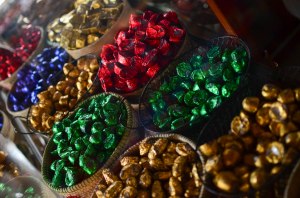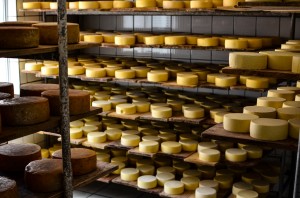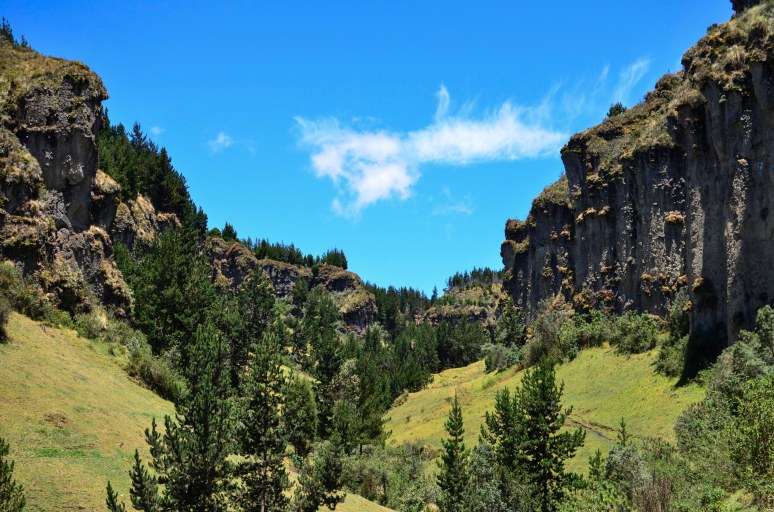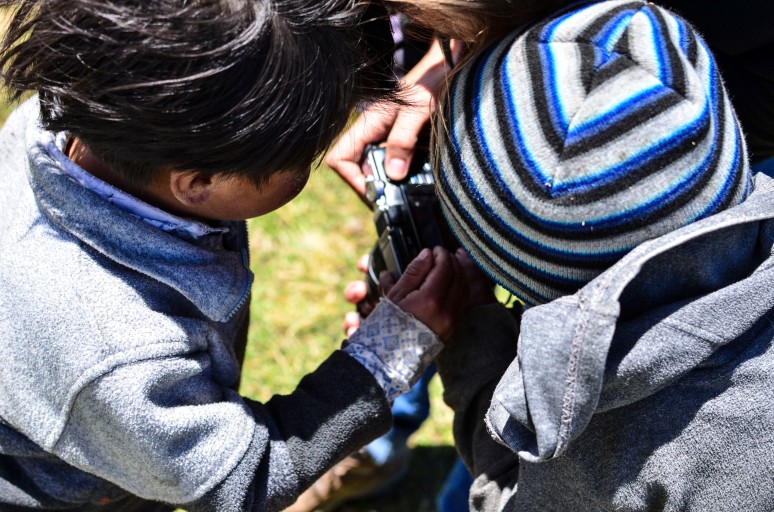Don’t go to Salinas de Guaranda. You might not leave.
Bus rides between destinations in the Andes carry an almost certain guarantee to have some of the most dramatic landscapes you’ll ever see. After leaving Riobamba we enjoyed another long encounter with Chimborazo, specifically the southern face of the dormant volcano. I could easily get swept up into a myriad of intricate details about how stunning the ride was, but I think I delved into my short lived love affair with her enough in the last entry. That being said, the hour or so we drove closer into the reserve & towards the mountain was pure magic. Much like the last bus ride most passengers were local folks who were mainly sleeping while we were drooling on our windows. It was serendipitous that we were assigned seats on the right hand side of the bus by the ayudante in the bus depot because we were front and center for the entire show, watching the clouds play hide & seek with the enormous sleeping giant. Eventually we looped around and began pulling away from the mighty mountain until it disappeared out of our sight and out of our lives. The wild landscape slowly disappeared & we found ourselves in a small town where we would wait for our next mode of transportation to pick us up in a dusty little plaza.
We knew we were going into a really small, really sleepy village so we went around the small city a little bit to stock up on necessary staples of granola, bananas, and other various fruits & snacks. Experiences had shown us in the past that items will often be scarce in more remote habitats. Honestly, I couldn’t really go anywhere without a healthy stock of bananas at this point in the trip. I had developed both a physical & psychological attachment towards the damn fruit, and the fact that they were so ubiquitous in these countries only added fuel to the fire. Pound for pound, they were my go to snack for about 10 months, an addiction that still carries on to this day. After finding a dozen or so bananas we waited at a small plaza in a round about for a collectivo that was supposed to make the loop to Salinas.
A small pick up truck affixed with a sturdy open metal frame on it’s bed and a neon sticker reading “Salinas” pulled up curbside in the plaza and onto the back we went. At first it was just us on the back of a pickup truck rolling through town. But as we moved along we seemed to stop every so often to let another person or two hop on. After 7 or so stops the truck bed was noticeably more dense with bodies, which made our large backpacks now seem excessive since they were taking up a shrinking portion of precious real estate. Small families, pets, live poultry, farmers, and even a woman nursing a baby was the cast and crew for the ride. We were all standing upright in a breathing-room-only bed of a pickup truck heading into the mountains ahead. Everyone was in good spirits as we meandered up a windy road through a valley. A small stream cut through the valley floor & followed us further into the hills & into the mountains, leading the way towards our destination.
We instantly knew that Salinas was the exact kind of medicine we were looking for. It was a small mountain town that was firmly planted in natural beauty, natural resources, and a naturally nurturing environment for nourishment to be procured. It was perfect in its simplicity. There was a tiny town center with a large open plaza surrounded by yellow and red colored houses and small rocky peaks in the near distance. We immediately noticed that something interesting was taking place as our truck came to a stop. At our drop off point there was a rag tag group of young kids using a soccer ball to play volley ball. They had a net set up and what appeared to be a regulation sized court. I couldn’t believe that this is the sport of choice these kids were playing in this setting. It was such a strange sight seeing the game that originated in New Springfield, Massachusetts over a 100 years ago all the way out in this little mountain town. On the sidelines there was a group of older men & women watching the kids play the sport while the day slowly crept onward.
Our lodging was dreamy to be perfectly blunt. Before arriving we did a little research & found that there was a small family run hostel that had a separate house kept for renting out rooms to visitors like ourselves. We trudged up a short brick road heading out of town and followed a few signs to the hospedaje. We struck a deal for a few nights stay with the owner who was naturally on site and waiting for us to arrive. The room was beautifully basic and authentically rustic. There was a wood burning fireplace which proved extremely effective in the chilly high elevation nights, and a small pile of wood placed outside of our door that would be replenished daily. Our cozy cabin was perched on a small flat area on a hillside overlooking the micro-town, complete with a ladder that gave us access to the roof where we could wash our clothes & let them air dry in fresh, crisp air.
Salinas had a mantra that it adopted & ingrained into the fabric of it’s society that was a refreshing perspective to see working first hand. About 40 years back, a priest named Padre Antonio Polo arrived from Italy and became integrated into the scene at Salinas. He shared a vision that was for the greater good of the people, leading by example & putting community first over individual desires. This kind of approach has created a socioeconomic society that carries itself upwards as a whole rather than the goals of capitalism of modern societies. Taken straight from the tourism brochure, Salinas de Guaranda, Pueblo de Economía Solidaria, Salinas’s vision is described: “Year after year, Salinas has been and continues to be home to the values of community and solidarity, where people come before money, the poor come before the rich, the weak before the strong, the sick before the healthy, and the small before the big.” The crazy thing was this is exactly how the town seemed to operate and from what we saw it was working just like that.
We decided to map out our day based on the natural features that Salinas had to offer & also taking a tour of the town’s cooperative businesses to see what the pulse of this community was all about. For our first stop we bee-lined it straight for the chocolate factory of course. This was probably one of the most established & sophisticated businesses set up at this town and was housed in a multi level building with lots of floor space. The main level was an entertaining hall with a large, expansive open room comprised of open space, long tables, and plenty of seating. Large windows gave the room a dramatic view of the hills & salt mines and was easy to imagine hosting a party here or handling large groups of tourists. Downstairs was a huge stainless steel kitchen area with workers fully suited & masked preparing & preparing the raw materials that go into the delicious chocolate treats they mass produce. They showed us a few rooms & equipment used before heading us back upstairs to the concession & chocolate stand area. Lots of high altitude chocolate treats were bought and consumed on the spot.
Next on our little self guided tour was the salt works. We walked down a path adjacent to the chocolate factory & went down a long flight of outdoor stairs towards the large chunk of exposed bedrock. The face of the cliff had interesting formations that kind of resembled a huge mound of melted ice cream. Since we didn’t join a tour group of any sorts, we were kind of exploring & not really sure what exactly was being done in these pools of salty, mineral rich water. It appeared that the water was being evaporated in large, flat areas & salt would be collected from the pools. We read that this salt was still being made as part of the artisanal economy from these mines, but I also I know from previous areas that had similar environmental conditions that this mineral rich water was probably good for healing purposes as well. We played with some salty mud, snapped a few pictures, and kept moving along.
After the salt mines we made our way towards the weaving co-op. This one was especially of interest to Elissa, for she had been waiting to find a good place to purchase some warmer clothing & gear and the idea of putting money directly into the hands that the goods was an idea very appealing to us. When we found the co-op we were greeted by a woman with a big, warm smile who let us explore the shop and explore at our leisure. The back room was filled with raw alpaca & wool spools in a wide variety of colors, old sewing machines, and a few women creating pieces in their studio. They were very friendly and we immediately got swept up into conversations, laughter, and smiles. Elissa’s mom has a deep affection for knitting, so I made sure I took a bunch of images for her to see (I know you’re reading this right now C!). I was particularly fascinated with hand portraits for an on-going series I have, and they were happy to let me snap away. It was a pretty intimate moment & the openness & charm of the Latino culture once again showed us that the world is a good place full of good people. We didn’t walk out of the coop without buying sweaters that we knew were made right in that little shop in town by honest hands & genuine smiles.
On to the cheese. This town had tons of fresh cheese going on, which was more than fine by me. How cheese production came into play was another fascinating story of a foreign visitor & his influence on the natural beauty & resources Salinas had to offer. A Swiss fellow named Jose Dubach taught the town locals how to produce artisanal style cheeses in tradition with techniques from his country. At first, cheese production was limited in scale & was a bit of a learning process, but eventually through networks of families, farms, & distribution methods the cheese business took off & became a backbone of the local economy of Salinas. Today around 120 workers tend to around 70 rural cheese plants, which also helps support over 1200 farming families in the area. It was one of the first cooperative successes of Salinas & became the example that the community used to create it’s flourishing & sustaining economy. The production in the factory building was very streamlined from start to finish and it was no wonder why so much fresh cheese was produced by this little town. The tour showed us how all the milk collected & brought into town on horseback, donkeys, & alpacas would go from a warm, fresh liquid into a block of delectable cheese.
Another business we were particularly interested in was the soccer ball factory. That’s right, somewhere in this post stamp sized village was a little building that made soccer balls which would eventually be played with on grassy fields & concrete plazas throughout the country. When we found the building there wasn’t really any signage indicating what to do or where to enter, just a single door in the middle of the building & stairs leading up to a 2nd floor. I knocked on the lower level door with no luck, so I tried knocking on the door upstairs. I recall a door opening & getting a very puzzled look from the person who opened the door. I think we probably caught them a little off guard, as nobody seemed to be working that day and the organized tour group for the day had probably already passed through. A pregnant woman came out with some of her kids and opened up the factory to give us a full tour. We went upstairs into a room with a bunch of stations that each had a small table & work space area for each step of the process. The machines looked like old tools I would find in my dads garage, but each modified for the specific task it was performing. We walked through the assembly process step by step in a few minutes and asked a bunch of questions, snapped a few photos. We decided that we would spend some of the Penny Karma money we had been getting through the donation page for buying soccer balls directly from the source. The idea was that we would find the right place to give these balls out when the opportunity arose as part of a gift back to the communities we were exploring. It would be a way of us giving back to the places that were giving us so much. So we bought a few small soccer balls & a few regular sized ones & let the family get back on with their day.
By the end of our tour, we had collected a bunch of different items from multiple different cooperative businesses. Our collection consisted of soccer balls, sweaters, soap, different types of cheeses, cured sausages, chocolate, fresh bread, crackers, jam, apples, & a bottle of wine. We made a homemade Salinas supper in front of a warm fire and couldn’t have been more pleased with the outcome. It was a real & genuine feeling knowing that our meal came from the land around us. I’ll remember that cozy meal by the fireplace place forever.
After devouring Salinas in a slow & savory way we chose to spend a day going on a hike outside of town & into the Páramo. There was a beautiful little hiking path that was just beyond some houses that took us past a town water supply station & into a valley. Steep, spear shaped pillars of rock adorned the cliffs on either side with the occasional cave at the base. The valley became increasingly narrow as we moved along, converging in on itself. The path eventually split into 2 directions, and we chose a small path to the left. It carried us up a very steep trail, occasionally riddled with pines that were cut down by what was probably a logging operation. After a particularly steep jaunt the treeline disappeared & we were looking into a wide open field full of wild hay. The landscape was vast, hilly, & felt larger than life in size & stature. We hiked upwards through the golden straw, observing the wide open fields around us. We made our way towards a small house built into the hillside & spotted a bunch of small clearings surrounding it. We found about a dozen or so sheep by the small abode, clearing the hay by eating it down to the earth in the radius of their rope/stake situation.
Aside from a few sheep, it seemed like we were the only living beings around up in those hills. The light was as clear as I’ve ever seen it. The wind was blowing steady, creating golden waves in the hay that pulsated in an endless break across the vast sloped terrain. We trekked down to a fence line and crossed a small stream into a field that was devoid of tall hay and had interesting rock outcrops that had grabbed my attention. As we approached the small cliffs jutting out of the ground we kept finding trash, both scattered around and collected in random nooks. We walked through a miniature valley and came across two young boys, probably around 4 & 5 years of age at their tiny little homestead & farm. Their dog approached us and was being loud and aggressive, but the boys quickly noticed we were not cool with it’s demeanor towards us. The older boy took either a rock or some round object and whipped it at the dog, striking it in the back while cursing at it. The dog stopped barking at as and took off back towards the house, and I couldn’t help but get a chuckle out of the whole ordeal. They were very surprised to see us wandering around and we became friends pretty quickly with the basic Spanish they were speaking with us. They were very curious about my camera and our phones, so we showed them how to take pictures using both. I was trying to imagine living in this setting as children, and how their days compared to my own as a kid. Their parents must have been out doing work for the day, as it was just the kids, their dogs, and their alpacas. Their house was very small & basic, with no signs of electricity & a wood burning wood stove for cooking & warm seemed to be it’s main utility. After playing with the kids for a little while longer, we said adios & walked back to town.
Salinas hadn’t let us go without keeping a piece of our souls with it. We had so many stories to tell about this tiny, close-knit village and couldn’t help but feel that we had struck gold going and seeing it for ourselves. It’s rare to find a place that has seemed to have kept it’s personality in check while dealing with the influx of tourism. The mantra that the community has established & implemented has certainly seemed to have reached the goal that it set out to capture. The slow moving charm and preservation of cultural heritage also doesn’t hurt this post-card perfect town’s image either. Salinas taught me a lot of simple life lessons that have been resonating in my mind as of late, and I don’t mind taking the ride again on that small pick up truck bouncing our way upwards towards our town in the mountains.











































Such beautiful photos! Reminds me of my time in Peru! Looks like you having an amazing time – enjoy! X
That cheese looks tasty!
Amazing photographies!
I love South America!!Like this blog!
Everything about this post is beautiful.
Awesome photographs that took me to the world of South America! The description of your journey that you have mentioned in detail is engrossing. Thanks for sharing your beautiful experience with your readers.
Reblogged this on The Adventures of Paul and Sue and commented:
Fantastic Photography
I’m sure you hear this a lot, but you are amazing at taking pictures. Good job.
good document, good pictures .. October 25 .. going there if someone wants to come !!!!!?